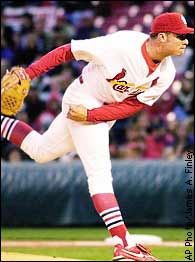|
|
|
|
 |
| ||
|
Scores Schedules Standings Statistics Transactions Injuries: AL | NL Players Weekly Lineup Message Board Minor Leagues MLB Stat Search Clubhouses | ||
| Sport Sections | ||
|
| ||
| Tuesday, June 6 | |||||||||
| Big bonuses bad news for bad teams ESPN.com | |||||||||
It's time once again for another June baseball draft. Which brings us to
ask one question:
The way the rules read now, some teams can spend almost an entire year playing negotiating pepper with their draft picks -- up until two weeks before the next year's draft if a player doesn't go back to school. Or those talks can stretch until the day the player starts classes if he does go back to school -- whether that's in September, January or the first day of the semester of his choice. Boras, in particular, has used that lack of a firm deadline to maximum effect. He's sent Drew to the Northern League and Bobby Hill to the Atlantic League. He's had other players register for classes but then never actually attend any. He's had numerous clients threaten to go back to school, when they actually had no intention of ever using another No. 2 pencil. The longer these marathons last, the more nervous some teams get. And that's one of many reasons draft bonuses have been escalating at an insane rate of 25 percent per year in recent years. So Indians scouting director John Mirabelli proposes a firm August 15 signing deadline as a means to bring this process to a head with the lowest Maalox dosage possible. "One thing I really think baseball should do is, we should put artificial pressure on ourselves," Mirabelli says. "Just say the deadline is August 15 and eliminate all the loopholes." No more Northern League threats. No more mad chases up the classroom steps. No more marathons. Sign by August 15 or think about the rest of your life. "You offer your $2 million or whatever," says one scouting director, "and you say, 'Take it or leave it.' Then you stick to your guns. Obviously, J.D. walked away, and an occasional guy will. But say Minnesota takes Matt Harrington at No. 2 this year and offers him $2 million. Is he really going to turn his back on $2 million coming out of high school? Very doubtful." "Eliminate the loopholes," Mirabelli says, "and I think the draft could still work." Try on a cap Up there in the big leagues, there's still a better chance the Players Association would allow all teams to play games wearing dresses than allow a salary cap on major league salaries. But if you listen to the rumble out of those clubhouses every year come draft time, you find a very different sentiment on the concept of a bonus cap for draft picks. "I think the players' union ought to get involved," says Royals scouting director Terry Wetzel. "I think major league players would like to see major league players getting the money instead of amateur draft picks." The union is obviously skeptical of a cap like this. But much of its membership is heavily in favor of it, just the way NBA players were before their union approved a similar cap. "I know the perception of some players is, the golden goose is going to keep kicking out more dollars, no matter what," Arbuckle says. "But the truth is, the more money that's spent on amateur players, that's $2 million or $3 million less for the big-league players. That might not be true on every club. But those clubs are the exception, not the rule. And I know that I personally would feel better, even if the total money spent comes out the same, if it were going to a guy who's been in the big leagues than a kid who you have no idea what he's going to do." So how would a cap like that work? There has been talk about a cap on total money spent per club per year -- for all signings. There has been talk about including the entire player-development system under a spending cap. But the worry there is that teams could circumvent that cap by handing out big-league contracts to players so they wouldn't fall under that umbrella. So another concept gaining steam these days is an NBA-type "slotting" process in which the signing bonus for each pick would be pre-determined. "I don't think we're talking about stopping the train or backing it up," Arbuckle says. "Just slow it down. We've got to stop paying $7 million or $8 million to guys who have never played an inning of pro ball. You throw out the exceptional situations, like what a Pat Burrell or a Drew got, and start with the numbers Josh Hamilton got last year ($3.96 million as the No. 1 overall pick). You start at $4 million for the No. 1 pick and work your way down from there." Fewer rounds Once, teams could draft as many players as they wanted in any given year. Then the draft was limited to 50 rounds. Now there is sentiment to cut that limit dramatically. "We're drafting for 50 rounds, and teams are signing 20-25 guys," Mirabelli says. "So let's cut it off at 30 or 25 rounds -- make it mean something to get drafted. Bigger pool. Fewer slots. I think it would be an improvement. That way, you can't take a guy in the 27th round and give him $900,000. You've only got so many picks. So you'd better take a guy where he belongs." International draft One of Boras' constant complaints about the draft -- and probably his most valid -- is that if some of these players were floating onto the shores of Costa Rica on a raft instead of living in San Diego, they'd be getting paid two, three, four or even five times what they're getting as draft picks. But you know baseball's response to that complaint isn't to make everyone a Cuban citizen. It's this: Worldwide draft. Baseball-operations VP Sandy Alderson is a huge fan of this idea. And he has many supporters. But some baseball people worry that it looks better on the drawing board than in reality. "The problem I have is with trying to enforce it," says one front-office man. "Our draft is set up around the educational system in the United States. But outside of the States, you're often looking at a whole different system. A lot of these kids don't play in any organized leagues. So how would we prevent clubs from hiding players until after the draft? I know this is a hot topic for Sandy, so it will continue to get pushed. But I don't know if it's enforceable." No draft at all All of these ideas have their merits. We'll grant that. But we say: Maybe we're trying to fix a contraption that's so broke, it can't be fixed. So why tinker? Let's blow the whole thing up and have no draft at all. Yeah, it sounds crazy. Yeah, it would mean the Yankees and Dodgers and other big spenders could throw $8 million or $10 million at every "special" player that came along. But the odds show that over time, they would make some very expensive mistakes. Lots of them, in fact. And in the meantime, those other teams -- the teams that don't want to be forced to pay their draft picks more than they pay their starting rotations -- could spend money in a far more efficient way: On players they actually wanted to sign, for dollars they actually wanted to spend. Of course, the catch is, you would have to convince those lower-income teams this would be a good thing for them. And they admit they need convincing. "We'd get killed," Ryan says. "If we had a kid we liked for $100,000, one of the bigger-revenue clubs would offer him $200,000. If we offered him $200,000, they'd offer him $500,000. The same 10-15 clubs that monopolize the international market now would monopolize the market here." But those teams would also blow a ton of money on kids that vanished more completely than Amelia Earhart. So it seems to us the clubs that scout the best would get the most out of the system. And that sure isn't always how it works now. "The one thing I like about this idea is that it would force us to be aggressive," Mirabelli says. "I'd go out and hire the best scouts around. And instead of paying our scouts like $25,000, I'd try to hire the 15 best scouts out there and pay them $100,000 apiece. Then I'd send them out there to beat people to the best players, to turn over every stone and look for players underneath every one of them." Why isn't that better than the current system, where money still talks and, when it doesn't, dishonesty walks? We go back to our original question: Does this draft work the way it was supposed to? Does it get gavel-to-gavel coverage on ESPN, as baseball draftniks everywhere hang on every pick? Has it made the Minnesota Twins any better? Let's review the answers: No. No. And no. So let's drop this draft into Scott Boras' dumpster and let free enterprise rule. It isn't guaranteed to be a better way. But face it: It can't be any worse. Jayson Stark is a senior writer at ESPN.com. | ALSO SEE Jayson Stark archive ESPN.com's baseball draft coverage Chat wrap: Scott Boras  | ||||||||

